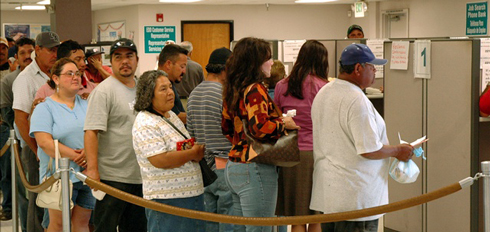Is inequality shortening your life span?
By Phillip Longman | Last updated: Oct 11, 2013 - 9:17:56 AMWhat's your opinion on this article?

While Blacks and Latinos typically face higher unemployment and worse health status than Whites, Black and Latino health status does show some improvement as income rises. Photo: MGN-Online
|
White, Black, or Brown, we’d all live longer in a more equal, less status-driven society
Imagine you got to choose whether to be born Black or born White in America. Here are a few health statistics that might inform your decision:
If you chose to be born White, your chances of dying of Parkinson’s disease would be twice as likely as if you chose to be Black. Your chances of dying from cirrhosis of the liver or Alzheimer’s disease would be 25 percent higher. As a White person, you’d also be two and a half times more likely to commit suicide.
Based on those facts alone, the decision to be born White might sound like a pretty bad idea. And sure enough, life doesn’t work out well for many millions of White people in America. But you might also consider that everyone has to die of something, and dying from these particular causes has some advantages.
As terrible as Alzheimer’s and Parkinson’s are, for example, almost no one dies of them unless they’ve previously managed to escape death from other causes for 75 years or more. Cirrhosis of the liver tends to kill at younger ages, but you can still spend many decades of hard drinking before it catches up with you. Even for the chance to commit suicide, one typically has to have survived at least until one’s teens, and suicide is more common among those who have succeeded in growing old than it is among those who are still young.

|
This would be particularly true if you chose to be Black and male.
To start with, your chances of dying before your first birthday would be roughly 2.3 times greater than if you were born White. If you managed to make it to age one as a Black male child, your chances of dying before your 5th birthday would be 80 percent greater. If you survived to age 15, you’d have a 60 percent greater chance of dying within the next 10 years. If despite these elevated risks of premature death you nonetheless managed to get to your 45th birthday, you’d still be 80 percent less likely to live long enough to collect Social Security than if you had chosen to be White.
If you were Black you would also, of course, substantially elevate your chances of growing up in a poor, crime-ridden neighborhood, and the health consequences of living in that kind of environment are extremely adverse. If your neighborhood were, say, New York’s Harlem during the 1990s, as a young man you’d have only a 37 percent chance of living to see 65. By contrast, according to a seminal study published in the New England Journal of Medicine, if you’d chosen to be White and wound up living in the unremarkable, predominantly White middle-class Detroit suburb of Sterling Heights, your chances of still being alive at 65 would be above 89 percent.
So what would you choose? It may be that longevity is not the only measure of the good life. You might also, with enough luck and fortitude, be able to overcome the highly elevated health risks of choosing to be born Black. Indeed, it is a curious fact that among Black males who live to an advanced old age (85 years or older), the chances of living for another year are actually greater than for White males of the same age-presumably because the few Black men who have survived that long have remarkable constitutions.
Yet who would ever choose to face this pattern of competing health risks across their life course? It’s far more important to have a good chance to become elderly in the first place than to embrace the tiny chance of becoming a centenarian in the unlikely event you’re not already dead by 65.
The vast disparities in health and longevity that exist between the races in the United States violate a fundamental idea of justice that we all carry with us at least to some degree. It is the idea of justice as fairness, of what kind of world we would choose to live in if, as the philosopher John Rawls framed it, we were all impartially situated as equals before being born and did not know what our station in this life would be. A society that resists ending the preventable causes of these racial disparities in heath is a society resisting justice.
But what are those preventable causes, and what could or should be done about them? To answer that question, let’s consider another thought experiment.
Imagine if, before you were born, you were told that you could choose to be born either Black or White in America. But if you chose to be White you would live in poverty and if you chose to be Black, you would be in the lower-middle class. In this thought experiment, you wouldn’t know anything about what our world is actually like except for estimates of life expectancy for different categories of people.
Those estimates would tell you that choosing to be White would bring you very little, if any, advantage to health if you were also poor. For example, according to data developed by the Robert Wood Johnson Foundation, approximately 35 percent of Whites living below the poverty line report themselves to be in only poor or fair health. This is quite close, after we adjust for age differences, to the 32 percent of poor Blacks who report fair or poor health.
Meanwhile, the health status of both Blacks and Whites improves dramatically with higher income while the gap between them remains small. Among Blacks and Whites living at just four times the poverty rate, for example, the percent who report poor or fair health drops to 8 percent and 6 percent respectively. Your race per se, in other words, plays little role in predicting your health compared to your income.
What explains the residual difference in the health status of Blacks and Whites who have the same-size paycheck? Researchers suggest it may reflect in part the reality that at any given income level, Blacks tend to have fewer assets than Whites, such as home equity and financial savings. A Black family earning, for example, $50,000 in income is less likely to own its own home, less likely to have received an inheritance, and more likely to be encumbered by debt than is a White family with the same income. Middle-class Black families are also more likely than middle-class White families to bear the health consequences of having lived in poverty in the past.
The gap in health status may also reflect the fact that among families with similar levels of income, as well as educational attainment, Blacks are more likely than Whites to live in neighborhoods with higher concentrations of crime, poverty, pollution, liquor stores, “junk food” outlets, and inferior health care. Conscious or unconscious bias among health care providers may also be at work in explaining the racial health gap, though your chances of receiving substandard health care in the United States vary far more according to where you live than according to the color of your skin.
Yet even if they remain remarkably small at any given level of income, racial disparities in health do exist. And these disparities are large enough to make it rational (if health and life expectancy are the only criteria) to prefer being born a poor White American than a poor Black one. But the differences are also far too small to make it rational to prefer being born a poor White to being born a rich, or even lower-middle-class, Black. Again, the health status of Blacks who live at just above the poverty line is substantially better than that of Whites who live below it.
There is a reason why, in English, we use the word “poor” to refer to both a lack of money and a lack of health. Both historically and still largely today, poor people are likely to have poor health, almost regardless of other circumstances.
That poverty is deadly is not hard to understand, at least at the extreme. To be very poor means not having enough to eat, being exposed to the elements, and living in areas where homicide and addiction are leading causes of death or where your access to appropriate health care is minimal or nonexistent. In addition, both historically and today, getting seriously sick is likely to make you seriously poor even if you weren’t before.
But if our goal is to overcome the vast disparities in health that exist in the United States, especially for Black Americans, we have to absorb two more difficult facts. These facts are noncontroversial among epidemiologists, even if they remain unfamiliar to most Americans.
First, it’s not just extreme poverty that is bad for your health; so is having less autonomy and status than others, regardless of your income. Among people who have plenty to eat, have equal access to quality health care, live in safe neighborhoods, and hold down jobs, health and life expectancy declines with socioeconomic position. While it is not hard to understand why truly impoverished people of all races die younger than middle-class people, it’s also true that middle-class people die younger than upper-middle-class people, and that upper-middle-class people die younger than rich people, even though none but the very poor are wanting for the basic necessities of life.
The second fact is just as strange, and equally radical in its implications, both for individuals seeking to maximize their personal health and for societies that are intent on creating just institutions. It is that the wider the disparities in status and power that exist between people within a given workplace, city, county, state, or country, the more premature deaths happen. Crudely put, inequality kills.
(Phillip Longman is senior editor of the Washington Monthly. This article is excerpted from a longer piece that is the final installment of an 11-part series on race, sponsored by the W. K. Kellogg Foundation and originally published by the Washington Monthly Magazine.)
INSIDE STORIES AND REVIEWS
-
-
About Harriett ... and the Negro Hollywood Road Show
By Rabiah Muhammad, Guest Columnist » Full Story -
Skepticism greets Jay-Z, NFL talk of inspiring change
By Bryan 18X Crawford and Richard B. Muhammad The Final Call Newspaper @TheFinalCall » Full Story -
The painful problem of Black girls and suicide
By Charlene Muhammad -National Correspondent- » Full Story -
Exploitation of Innocence - Report: Perceptions, policies hurting Black girls
By Charlene Muhammad -National Correspondent- » Full Story -
Big Ballin: Big ideas fuel a father’s Big Baller Brand and brash business sense
By Bryan Crawford -Contributing Writer- » Full Story






 Click Here Stay Connected!
Click Here Stay Connected!








